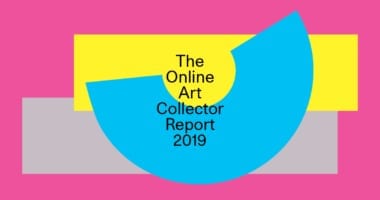
Online Art Market
The online art market includes all art objects available to buy and sell online, whether from galleries, auction houses, e-commerce companies, or online art platforms.
Why It Matters: In 2018, the online art market grew 10% to hit a new high of $5.4 billion. This segment accounts for roughly 8.5% of the overall art market, which reached a total of $63.7 billion in sales in 2017, according to Art Basel and UBS’ 2018 Art Market report. One of the biggest advantages of the online art market is its ability to reach a vast number of collectors and connect them to galleries and auction houses across the globe. Since its emergence, the online art market has dramatically expanded the overall art market, increasing opportunities for selling and collecting art.
Brick-and-Click
A gallery with both a physical location and an online presence.
Why It Matters: Per the 2018 Hiscox Online Art Trade Report, “almost three-quarters (74%) of online art buyers bought more than one art object online in the last 12 months.” Additionally, online buyers are growing more comfortable buying online, purchasing works at an average price point of over $5,000, an increase in average pricepoint from 2017. As more collectors come online, brick-and-click galleries are positioned to take advantage of the opportunity to form new relationships that have the potential to convert to sales. Physical and digital storefronts complement each other, and having both allows collectors to discover works online and then, if they wish to view them in person, travel to the gallery before finalizing a purchase.
SaaS
SaaS stands for Software as a Service. A popular service in the tech industry, SaaS is a network of applications providing software that runs on a centralized server that is accessible via the internet. Artsy’s SaaS products—the Content Management System (CMS) and Folio—function as a comprehensive suite of digital tools that increase access to your gallery’s online platform.
Why It Matters: Customizable and secure, SaaS provides infrastructure to support business operations. For example, Artsy’s CMS enables you to catalog and upload your inventory online and share it with Artsy users and collectors, and Folio syncs with CMS allowing you to create albums and curate shows from your collection. Easy to use and efficient, these tools enable you to spend more time engaging with artists and collectors and less time managing administrative duties.
Metadata
Metadata is data that describes other data. In the context of the art world, Metadata is information about artworks, artists, designers, and architects that serves to identify and classify them. For example, artwork dimensions, exhibition history, and price all fall under the category of metadata.
Why It Matters: Thanks to the Art Genome Project and galleries who upload artworks to make their listings discoverable for collectors, you can find metadata for many artists featured on Artsy listed on their artist pages. When researching a prospective work, collectors often like to know as much information as possible about the history of the artist and the piece. Providing this information helps collectors contextualize and better connect with the work they are interested in, increasing the likelihood that they will add it to their collection. In fact, according to the 2018 Hiscox Online Art Trade Report, “90% of new buyers said that price transparency was a key attribute and criteria when buying art online.”
Search Engine Optimization (SEO)
Search Engine Optimization, or SEO, is the process of affecting the visibility of a website or page in organic (non-sponsored) search results. SEO includes anything you can do to get your website content to show up higher and more frequently on search engines like Google.
Why It Matters: Understanding SEO and its most impactful factors can help your gallery become more visible on search engines. A higher position on the Search Engine Results Page (SERP) leads to higher engagement from collectors interested in content related to your gallery’s listings, which will, in turn, increase your opportunity to make sales. For more information, explore The Gallery’s Guide to SEO.
Online Buyer
A collector or prospective buyer who purchases art online, either through a third party platform like Artsy or directly from a gallery or auction house’s website.
Why It Matters: The emergence of a younger generation of art collectors has led to a rapid increase in the number of online art buyers, as collectors are becoming more comfortable buying works they have not seen in person. According to a survey conducted by U.S. Trust, millenials are currently the fastest growing segment of art collectors. Just this year, 78% of millennial collectors purchased art online, up from 69% in 2017. Additionally, the internet provides an opportunity for collectors to connect with galleries around the world, regardless of their location. Per the 2018 Hiscox Online Art Trade report, “70% of galleries this year sold their artworks online to international clients – up from 54% in 2017.”
Online Sale
An online sale is “a sale where any part of the art sales process has an online element” (TEFAF Art Market Report: Online Focus). Similar to the means by which we assess Art Fair sales, if a user discovers an artwork on an online platform like Artsy but then purchases the work from the gallery offline, the sale is still considered an “online sale” because the online platform facilitates the initial connection between user and gallery.
Why It Matters: According to Hiscox, “52% of online buyers who bought art last year said they will be buying more art over the next 12 months.” Positioning your gallery in the online market introduces you to new collectors and increases your gallery’s reach, positioning you to take advantage of online sales.
Blockchain Technology
Blockchain technology enables the creation of a decentralized digital ledger or an ongoing record of transactions that became popular in the digital currency space, notably with the Bitcoin network. Within a blockchain, consensus can be reached without involving a central authority, the data is not stored centrally, and no transaction can ever be erased. This can be applied, for example, to the creation of purely digital smart contracts that don’t require a central arbiter, as seen in the Ethereum network.
Why It Matters: Blockchain technology has been proven to be a perfect fit for enabling the creation and distribution of unique digital artworks and collectibles. Additionally, artists (e.g., Kevin Abosch) have even embraced the blockchain as a medium.
Many problems in the art world, such as authenticity, traceability, or transacting across borders can be seen as consensus problems and can potentially be solved with the help of this technology. As Bitcoin and therefore blockchain grew in popularity, many organizations within the art world, ranging from collectors to galleries to online art platforms to auction houses, began thinking about ways to integrate it into the process of buying and selling art.
Mobile Commerce
Mobile commerce involves the use of wireless handheld devices, such as cellular phones, tablets, and laptops, to make transactional purchases online.
Why It Matters: Collectors’ use of mobile devices to inquire upon and purchase works online is growing rapidly. According to the 2018 Hiscox Online Art Trade Report, “the use of mobiles to buy art has increased significantly in recent years, rising to 20% in 2018 (up from 4% in 2015).” On Artsy, more than 50% of sales (in volume and value) come through mobile devices. In fact, the inquiry for Artsy’s highest known sale to date (a $2m work sold in 2018) was made via Artsy’s mobile site.
Augmented Reality
Augmented Reality, known more commonly as AR, is a technological feature that superimposes a computer-generated image into a user’s view of reality. Blurring the line between real and virtual realms, AR allows users to interact with their environment in an entirely new way.
Why It Matters: One of the biggest barriers remaining for many online collectors is the experience of viewing a three-dimensional work on a two-dimensional screen. In 2018, Artsy launched a new AR feature enabling collectors to virtually “hang” works on their walls through the Artsy iOS app, bringing users the most authentic digital viewing experience on the market. Features like AR help collectors visualize what a piece may look like in their desired space and in turn, potentially increases their likelihood to purchase without viewing the work in person.
Artsy Confirmed Buyer
Once a sale on Artsy has been verified, the user receives Artsy Confirmed Buyer status, indicating that they have followed through with at least one sale on the online platform. Identifying Artsy Confirmed Buyers increases the quality of your gallery’s experience on Artsy, as it ensures that all future galleries—including you—can proceed confidently when they receive a new inquiry.
Why It Matters: Artsy Confirmed Buyer status helps to establish trust between the gallery and the user, helping you proceed with confidence and make sales easily.



